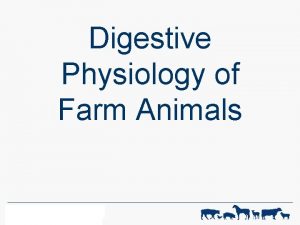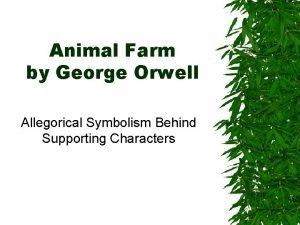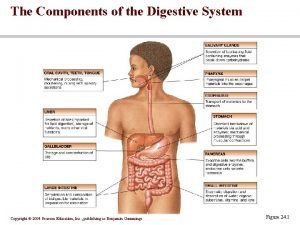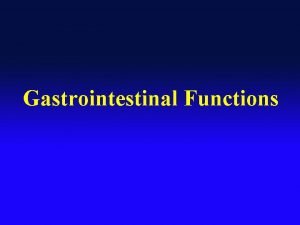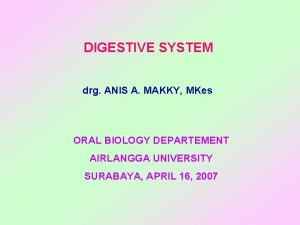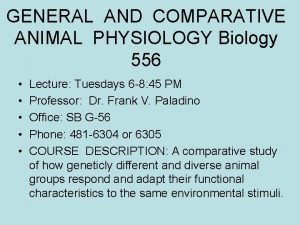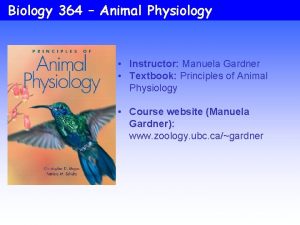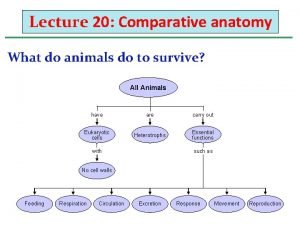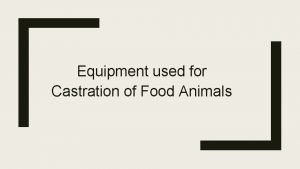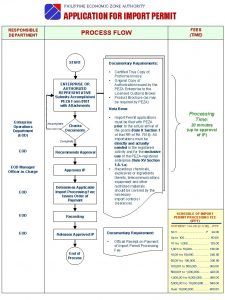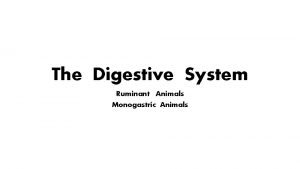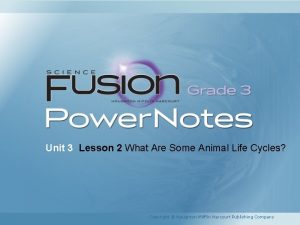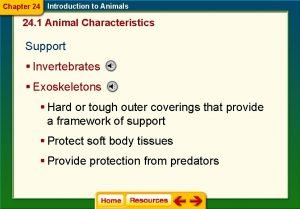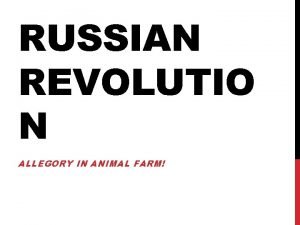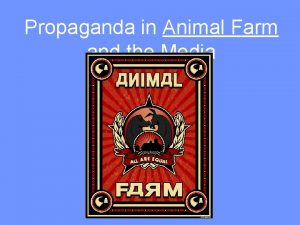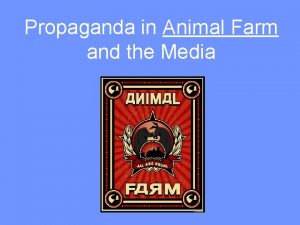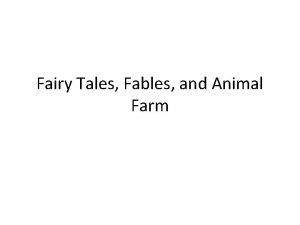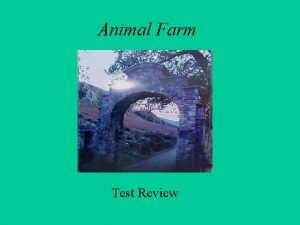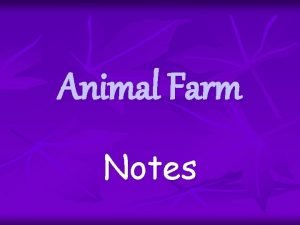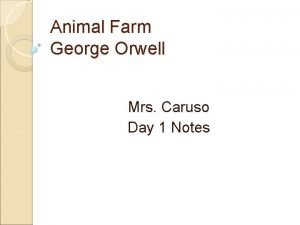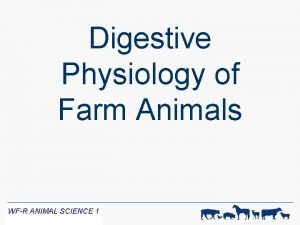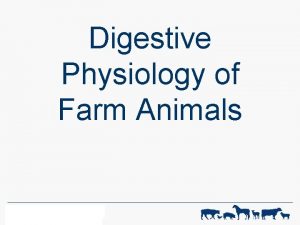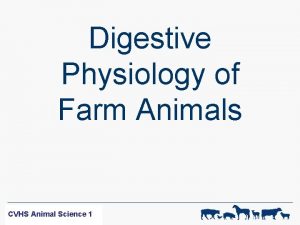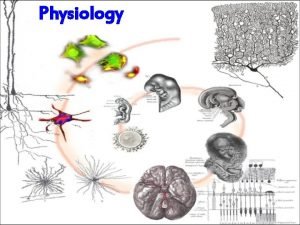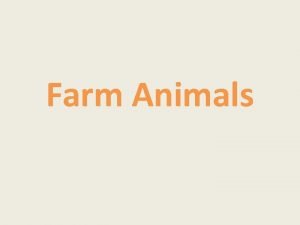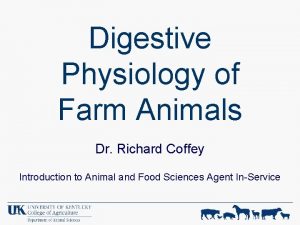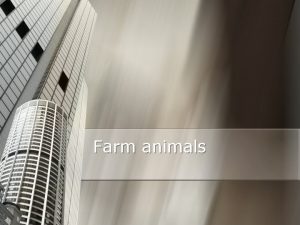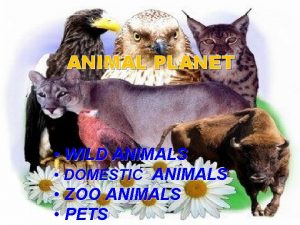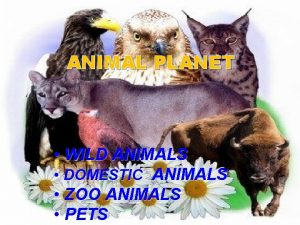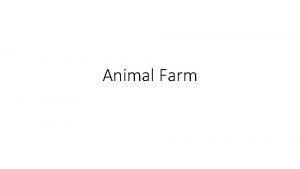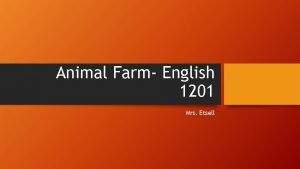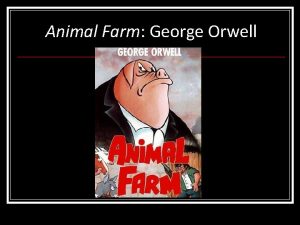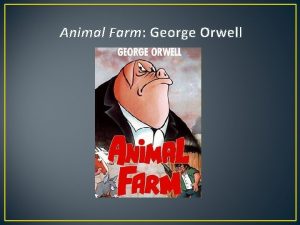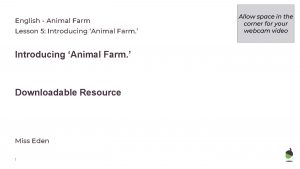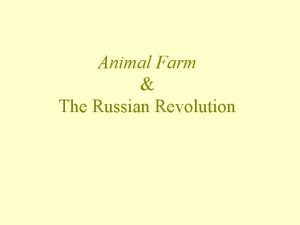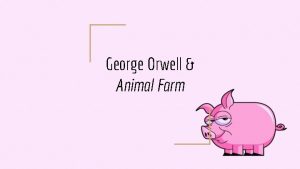Digestive Physiology of Farm Animals WFR ANIMAL SCIENCE











































- Slides: 43

Digestive Physiology of Farm Animals WF-R ANIMAL SCIENCE 1

Introduction n Three (3) basic types of digestive systems: ► Monogastric – simple stomach. ► Ruminant – multi-compartmented stomach. ► Poultry – simple stomach, but very large and complex large intestine WF-R ANIMAL SCIENCE 1

Types of Digestive Systems Monogastrics Pigs Dogs Cats Horses Human WF-R ANIMAL SCIENCE 1 Ruminants Beef Cattle Dairy Cattle Goats Sheep Deer Poultry Chickens Turkeys Ostrich

Basic Functional Anatomy of the Digestive System – Ruminants – WF-R ANIMAL SCIENCE 1

Digestive Tract – Beef Cattle Small intestine Rectum Pancreas Rumen Omasum Esophagus Reticulum Large intestine Cecum Liver Gall bladder WF-R ANIMAL SCIENCE 1 Abomasum

Digestive Tract – Beef Cattle WF-R ANIMAL SCIENCE 1

Organs of the Digestive System – Ruminants – « Mouth, esophagus, liver, pancreas, gall bladder, small intestine, and large intestine have functions similar to monogastrics. n Stomach ► Structure and function of the stomach is the major difference between monogastrics and ruminants. ► Multi-compartmented stomach – rumen, reticulum, omasum, abomasum. WF-R ANIMAL SCIENCE 1

Parts of the Ruminant Stomach n Rumen: ► Large, anaerobic fermentation vat. Rumen Capacity Species Normal capacity Maximum capacity Cow (1000 lb) 25 -30 gallons 55 -60 gallons Ewe (150 lb) 3 -5 gallons 5 -10 gallons WF-R ANIMAL SCIENCE 1

Parts of the Ruminant Stomach n Rumen (continued): ► Houses microorganisms. PProtozoa – 100, 000 per gram of rumen fluid. PBacteria/fungi – 100 million per gram of rumen fluid. ► Functions of microorganisms. PDigest roughages to make Amino Acids. ► Amino Acids absorbed in rumen. WF-R ANIMAL SCIENCE 1

Parts of the Ruminant Stomach n Rumen (continued): ► Lined with millions of papillae (short projections on wall of rumen) needed for absorption. P“Shag carpet” appearance WF-R ANIMAL SCIENCE 1

Parts of the Ruminant Stomach Rumen (continued): ► Rumen saturated with gases and in constant motion. ► Contractions occur at a rate of 1 -3 per minute. PServe to mix contents, aid in mixing of gases, and move fluid and fermented feedstuffs into the omasum. Taken from “Digestive Physiology of Herbivores” http: //arbl. cvmbs. colostate. edu/hbooks/pathphys/digestion/herbivores/ WF-R ANIMAL SCIENCE 1

Parts of the Ruminant Stomach n Rumination: ► Ruminants are well known for “cud chewing”. ► Rumination involves: PBolus of previously eaten foodstuff carried back into the mouth. PFluid in bolus is squeezed out with the tongue and reswallowed. May be up to 6 -7 times per Bolus PBolus is rechewed and reswallowed. ► Rumination may occupy about 1/3 of a ruminant’s day WF-R ANIMAL SCIENCE 1

Parts of the Ruminant Stomach ► Fermentation of foodstuffs in the rumen generates enormous quantities of gas. P 30 -50 liters per hour in adult cattle. P 5 -7 liters per hour in adult sheep or goats. ► Belching is how ruminants get rid of fermentation gases: PAnything that causes a hindrance to belching can be life threatening. PBloating can result in death from asphyxiation. WF-R ANIMAL SCIENCE 1

Parts of the Ruminant Stomach n Reticulum: ► Contains microorganisms (like the rumen). ► Provides additional area for fermentation. ► As fermentation by microorganisms proceed and feedstuffs are digested, smaller and more dense material is pushed into the reticulum (from which it along with microbe-laden liquid is ejected into the omasum). WF-R ANIMAL SCIENCE 1

Parts of the Ruminant Stomach n Reticulum (continued): ► Lining has a honeycomb structure. PCatches and holds hardware consumed by animal. PHardware can be removed with rumen magnate. WF-R ANIMAL SCIENCE 1

Telephone Cord WF-R ANIMAL SCIENCE 1

Wire WF-R ANIMAL SCIENCE 1

Ruminant Stomach esophagus reticulum rumen omasum abomasum Together the Rumen and the Reticulum make up over 85 percent of the Rumen Stomach WF-R ANIMAL SCIENCE 1

Parts of the Ruminant Stomach n Omasum: ► A heavy, hard organ with a lining that has many folds (leaves). ► Function not well understood. PBelieved to produce a grinding action on foodstuffs. WF-R ANIMAL SCIENCE 1

Parts of the Ruminant Stomach n Abomasum: ► The true, glandular stomach. PSecretes acids and functions very similarly to monogastric stomach. ► Unique feature is that it secretes lysozyme. PEnzyme that efficiently breaks down bacterial cell walls. PNeeded to break down the large quantities of bacteria that pass from the rumen. WF-R ANIMAL SCIENCE 1

Ruminant • Wanna see the real thing? Take a look at this clip… • http: //www. youtube. com/watch? v=JSl. Zjgp F_7 g WF-R ANIMAL SCIENCE 1

Basic Functional Anatomy of the Digestive System – Monogastrics – WF-R ANIMAL SCIENCE 1

Digestive Tract - Pig Liver Pancreas Cecum Rectum Esophagus Stomach Duodenum Small intestine (jejunum, ileum) WF-R ANIMAL SCIENCE 1 Colon

Digestive Tract - Pig WF-R ANIMAL SCIENCE 1

Organs of the Digestive System – Monogastrics – n Mouth ► Mechanical breakdown of foodstuffs by chewing (reduces particle size, increases surface area for action of enzymes). ► Saliva added as a lubricant and, in some species, contains amylase to begin starch digestion. n Esophagus ► Tube connecting the mouth to the stomach. WF-R ANIMAL SCIENCE 1

Organs of the Digestive System – Monogastrics – n Stomach ► Enzymatic digestion of proteins begins. ► Foodstuffs reduced to liquid form. n Liver ► Center of metabolic activity in the body. ► Major role in digestive process is to provide bile salts to small intestine (needed for digestion and absorption of fats). WF-R ANIMAL SCIENCE 1

Organs of the Digestive System – Monogastrics – n Pancreas ► Provides a potent mixture of digestive enzymes to the small intestine to help in digestion of fats, carbohydrates, and proteins. n Small Intestine ► 3 sections – duodenum, jejunum, ileum ► Site of final stages of chemical enzymatic digestion. ► Where almost all nutrients are absorbed. WF-R ANIMAL SCIENCE 1

Organs of the Digestive System – Monogastrics – n Large Intestine ► 3 sections – cecum, colon, rectum ► Site of water absorption from G. I. tract. ► Bacterial fermentation occurs (production and absorption of volatile fatty acids). PSomewhat limited in monogastrics ► Feces formed. WF-R ANIMAL SCIENCE 1

Basic Functional Anatomy of the Digestive System – Poultry – WF-R ANIMAL SCIENCE 1

Digestive Tract - Poultry WF-R ANIMAL SCIENCE 1

Digestive Tract - Poultry WF-R ANIMAL SCIENCE 1

Organs of the Digestive System – Poultry – Specialized Organs in Poultry n Beak ► No lips, no teeth, and no chewing. n Crop ► Out-pocketing of the esophagus that provides storage for consumed food. ► Foodstuffs moistened and softened (little if any digestion). WF-R ANIMAL SCIENCE 1

Organs of the Digestive System – Poultry – Specialized Organs in Poultry (continued) n Proventriculus ► Glandular stomach where the first significant amount of digestive juices are added. n Gizzard ► A muscular organ used to grind and break up food. ► May contain grit (small stones) eaten by animal. WF-R ANIMAL SCIENCE 1

Organs of the Digestive System – Poultry – • Grit that is commonly added to chicken feed to aid in digestion. WF-R ANIMAL SCIENCE 1

Organs of the Digestive System – Poultry – • Feed has to be very high in nutrients due to the rapid movement through the digestive system. WF-R ANIMAL SCIENCE 1

Organs of the Digestive System – Poultry – Specialized Organs in Poultry (continued) n Vent ► Common chamber into which the digestive, urinary, and reproductive tracts open. PWhen fecal material is excreted, the vent folds back allowing the rectal opening of the large intestine to push out, closing the reproductive tract opening. WF-R ANIMAL SCIENCE 1

Specialized Poultry Organs Crop Gizzard Vent Proventriculus WF-R ANIMAL SCIENCE 1

Summary WF-R ANIMAL SCIENCE 1

Summary n There are three (3) basic types of digestive systems in farm animal species. ► Monogastric ► Ruminant ► Poultry n The type of digestive system influences the dietary foodstuffs the animal can effectively utilize. n http: //www. youtube. com/watch? v=J 9 tf. Zx. BIec 8& NR=1&feature=endscreen WF-R ANIMAL SCIENCE 1

Digestive Tract Capacities Sheep/Goats Cattle Swine Horses 5 -10 gal 55 -60 gal ---- Reticulum 1. 5 qt 3 -4 gal ---- Omasum 1 pt 1 -2 gal ---- 1. 5 qt 3 -4 gal ---- 2 gal 2 -3 gal 2. 5 gal 17 -18 gal 2. 5 gal 12 -15 gal 85 -90 ft 130 ft 60 ft 70 ft 1. 5 gal 10 gal 30 -35 gal Rumen Abomasum Stomach Small intestine length Large intestine WF-R ANIMAL SCIENCE 1

THE END Any questions? WF-R ANIMAL SCIENCE 1

WF-R ANIMAL SCIENCE 1

Digestive System Paper Introduction Similarities: Ruminant and non-ruminant Differences: Ruminant vs. non-ruminants Differences : Poultry vs. Ruminant and Nonruminants Conclusion WF-R ANIMAL SCIENCE 1
 Kronos middleware
Kronos middleware Digestive system of a farm animal
Digestive system of a farm animal Harmouns
Harmouns What does benjamin represent in animal farm
What does benjamin represent in animal farm Digestive physiology ppt
Digestive physiology ppt Digestive physiology
Digestive physiology Parasimpathetic
Parasimpathetic Unit 26 agriscience
Unit 26 agriscience Comparative animal physiology notes
Comparative animal physiology notes Manuela gardner
Manuela gardner Human physiology exam 1
Human physiology exam 1 Unit 26 animal anatomy physiology and nutrition
Unit 26 animal anatomy physiology and nutrition Invertebrate respiratory system
Invertebrate respiratory system What is a witches favourite subject in school
What is a witches favourite subject in school Https//a-z-animals.com
Https//a-z-animals.com Animals that eat both plants and animals
Animals that eat both plants and animals Parasitic food chain
Parasitic food chain Carnivore
Carnivore Animals
Animals Peza form 8105 sample
Peza form 8105 sample Meaning of farm planning
Meaning of farm planning International anatomy olympiad
International anatomy olympiad Science olympiad anatomy and physiology 2020 cheat sheet
Science olympiad anatomy and physiology 2020 cheat sheet Sheep digestive system
Sheep digestive system Define todays
Define todays Copyright
Copyright Lesson 2: animal body plans: 1 biology b unit 3: animals
Lesson 2: animal body plans: 1 biology b unit 3: animals Assaf hamdani
Assaf hamdani Introduction to animals section 1 animal characteristics
Introduction to animals section 1 animal characteristics The seven commandments in animal farm analysis
The seven commandments in animal farm analysis Animal farm excerpt
Animal farm excerpt Figurative language in the book thief
Figurative language in the book thief Unwarranted extrapolation propaganda examples
Unwarranted extrapolation propaganda examples Name calling examples
Name calling examples Bandwagon animal farm
Bandwagon animal farm Animal farm propaganda poster
Animal farm propaganda poster Animal farm chapter 6 worksheet answers
Animal farm chapter 6 worksheet answers Animal farm google drive
Animal farm google drive Animal farm fairy tale
Animal farm fairy tale Whos boxer in animal farm
Whos boxer in animal farm Zusammenfassung animal farm
Zusammenfassung animal farm What are some quotes from napoleon in animal farm
What are some quotes from napoleon in animal farm Animal farm conflict
Animal farm conflict Animal farm exposition
Animal farm exposition

